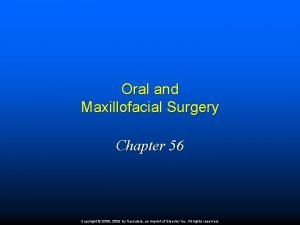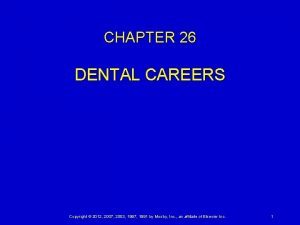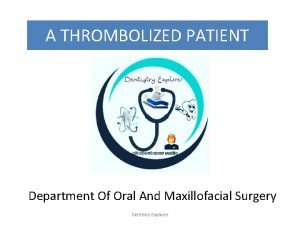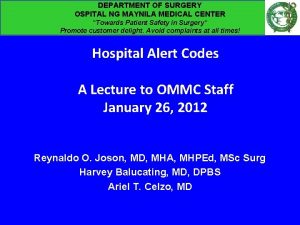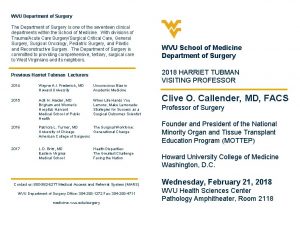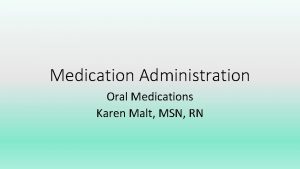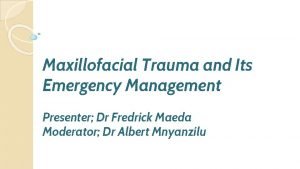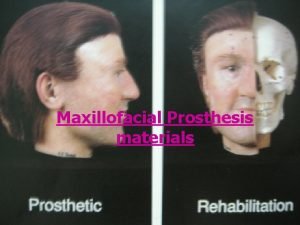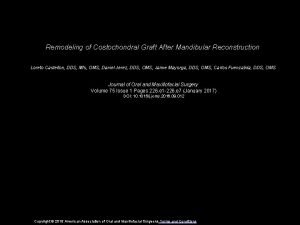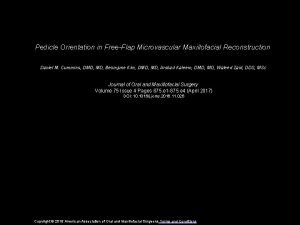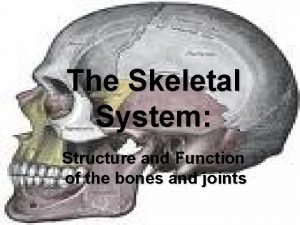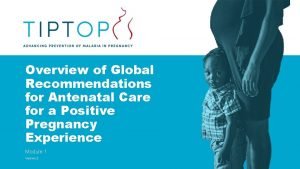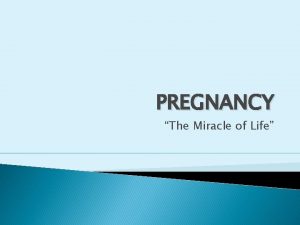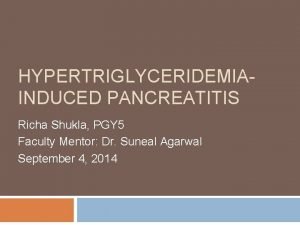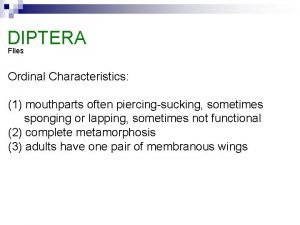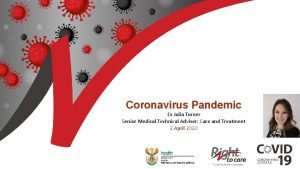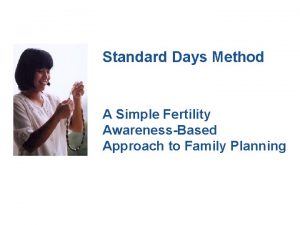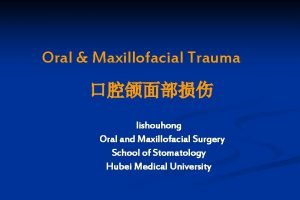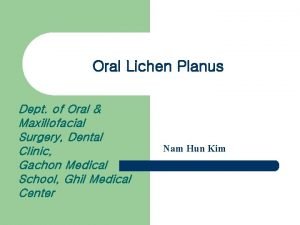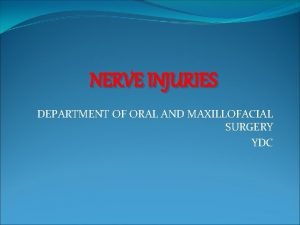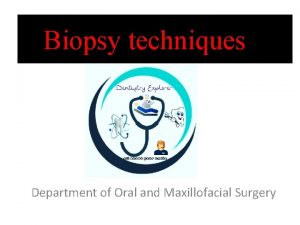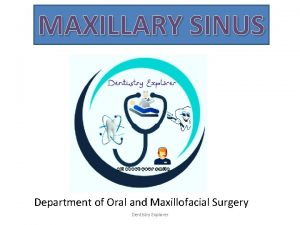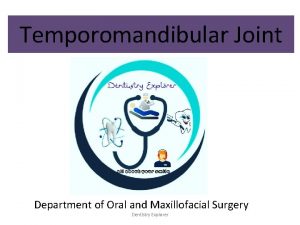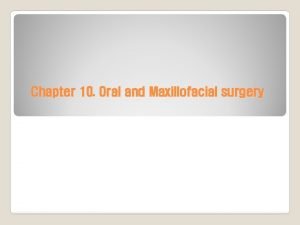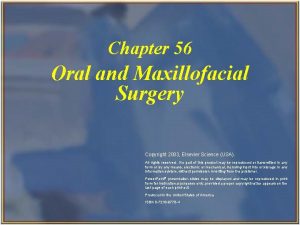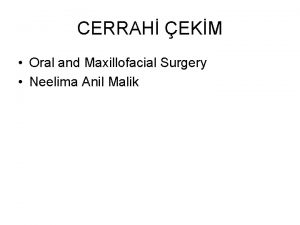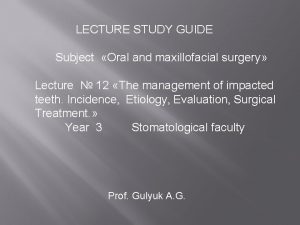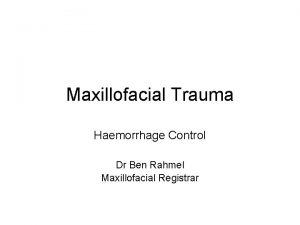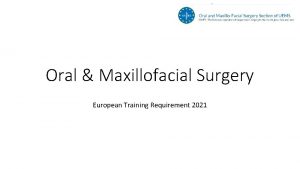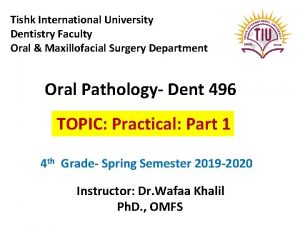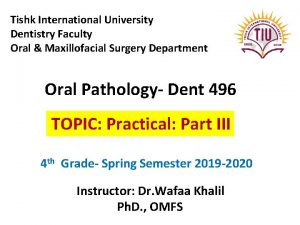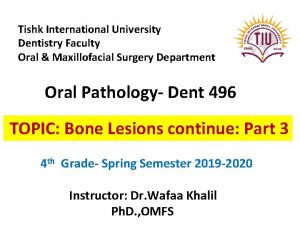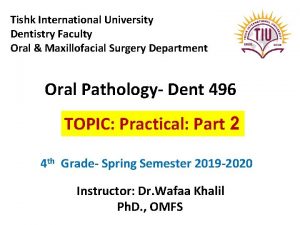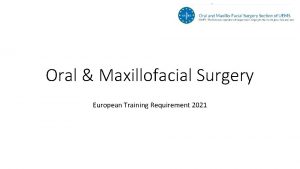PREGNANT PATIENT Department of Oral and Maxillofacial Surgery




























- Slides: 28

PREGNANT PATIENT Department of Oral and Maxillofacial Surgery 24 February 2021 Dentistry Explorer 1

CONTENTS v Stages of pregnancy v Role of hormones v Clinical presentation v Management & elective dental treatment v Drugs used in pregnancy v Conclusion 24 February 2021 Dentistry Explorer 2

Stages of pregnancy 1 st trimester: 1 -12 week “Psychological stage” During organogenesis take place. this stage, 2 nd trimester: 13 -24 week “Sense of well being stage”. During this stage proper formation take place of baby. 3 rd trimester: 25 -40 week “Supine stage” during this stage , formation and positioning take place of baby. 24 February 2021 Dentistry Explorer 3

Role of Sex Hormone Estrogen Increases cellular proliferation in blood vessels (known in the endometrium). Decreases keratinization, while increasing epithelial glycogen. Specific receptors are found in gingival tissues. 24 February 2021 Dentistry Explorer 4

Progesterone Increases vascular dilation, and thus increases permeability (resulting in edema and accumulation of inflammatory cells). Increases proliferation of newly formed capillaries in gingival tissues (increased bleeding tendency). Alters rate and pattern of collagen production. Increased metabolic breakdown of folate (folate deficiency can inhibit tissue repair). Specific receptors are found in gingival tissues. Decreases plasminogen activator inhibitor type 2, and thus increases tissue proteolysis. 24 February 2021 Dentistry Explorer 5

24 February 2021 Dentistry Explorer 6

24 February 2021 Dentistry Explorer 7

Supine hypotensive syndrome • During 2 nd and 3 rdtrimester, Patient in the supine position Decrease in blood pressure and cardiac output Decreased venous return to the heart Due to the compression of the inferior vena cava by the gravid uterus light-headedness, hypotension, tachycardia, and syncope. Raise right hips by 10 -12 cm or inclined to the left while seated on a dental chair. 24 February 2021 Dentistry Explorer 8

Oral manifestation Cause: Bacterial plaque, pregnancy accentuates the gingival response to plaque & modifies the resultant clinical picture. Severity is increased in beginning in the 2 nd & 3 rd month. More severe in 8 th month & decreased the ninth month of pregnancy. Clinical feature: site- Marginal & interdental gingiva Moderate form of pregnancy gingivitis Colour: Bright red to bluish red. Consistency: Edematous, pit on pressure, soft , raspberry like appearance. painless unless complicated by acute infection. may be associated with transient tooth mobility. Figure Severe pregnancy gingivitis with hyperplasia in patients with poorly controlled non– insulin-dependent diabetes mellitus. A, Moderate gingival enlargement. B, Severe gingival enlargement. 24 February 2021 Dentistry Explorer 9

Others…. Xerostomia Ø Dental Caries Ø Saillorhea Ø Increased tooth mobility Ø Perimylosis Ø 24 February 2021 Dentistry Explorer 10

24 February 2021 Dentistry Explorer 11

24 February 2021 Dentistry Explorer 12

24 February 2021 Dentistry Explorer 13

Risk of dental Radiograph • High dose (over 250 rads) prior to 16 weeks Microcephaly Mental retardation Cataracts Growth retardation Spontaneous abortion • High dose after 20 weeks Hair loss Skin lesions Bone marrow suppression 24 February 2021 Dentistry Explorer 14

Dental Radiography and Pregnancy • Concern exists for the safety of dental X-rays in pregnant patients and operators. • The ADA recommends the use of aprons and thyroid shields for pregnant patients, and dosimeters and work practice controls for pregnant operators. • The American College of Obstetricians and Gynecologists Committee on Health Care for Underserved Women reaffirmed its committee opinion in 2015: “Patients often need reassurance that prevention, diagnosis, and treatment of oral conditions, including dental X-rays (with shielding of the abdomen and thyroid) is safe during pregnancy. ” 24 February 2021 Dentistry Explorer 15

Dental radiographs • X-ray only if necessary (i. e. root canal therapy, trauma) • When x-rays are indicated, radiation exposure is extremely low • Exposure can be limited by: Lead apron shielding Modern fast film. Dentistry Explorer 24 February 2021 16

24 February 2021 Dentistry Explorer 17

Are medications safe during pregnancy? ? ? 24 February 2021 Dentistry Explorer 18

FDA DRUG CLASSIFICATION CATEGORY EFFECT OF DRUGS A Controlled studies in women with no evidence of risk in any trimesters and possible of fetal harm appears remote EFFECTS OF DRUGS Either animal studies have not demonstrated a fetal risk but there is Positive evidence of human fetal risk exists, no controlled studies in pregnant women (may have risk in first but benefits for pregnant women may be trimester but no evidence of risk in later trimesters) acceptable despite the risk , as in life threatening condition where safer drugs are Either studies in animals have revealed adverse fetal effects and no ineffective. controlled evidence in wome or animals. Given, if safer alternative are not avialable CATEGORY B D C E Eithe studies in animals or hman beings have demonstrated fetal abnormalities. Contraindicated in women who are or may be pregnant. 24 February 2021 Dentistry Explorer 19

Commonly used drugs in dentistry Analgesics Category Paracetamol Ibuprofen Diclofenac Tramadol B B/D, , caution, avoid in third trimester C/D C Antibiotics Category Amoxicillin Doxycycline Metronidazole B D B Antifungal( Fluconazole) C Steroids- Triamcenolone 24 February 2021 Wysolone C Dentistry Explorer C 20

Antiviral( Acyclovir) B Anticonvulsants- Phenytoin Carbamazepine Phenobarbitol D D D Antidepressants( Amitryptylline) C Local anesthesia with epinephrine - Lidocaine B Multivitamins A Chlorhexidine gluconate B Haemorheological – Pentoxiphyline C 24 February 2021 Dentistry Explorer 21

Effect of LA in pregnant women Ø Ester-types are rapidly hydrolyzed in the mother's plasma, and thus have few effects on the fetus. Allergic reactions caused by local anesthetics can pose a danger for both the mother and the fetus, and ester-types are more likely to induce these allergic reactions. Ø In comparison, the likelihood of amide-type local anesthetics inducing allergic reactions is very low. 24 February 2021 Dentistry Explorer 22

• Bupivacaine is known to have the lowest fetalto-maternal ratio. • Bupivacaine should have the smallest effects on the fetus among all amide types. For this reason, bupivacaine is widely used as a local anesthetic in the field of obstetrics. However, at toxic levels, bupivacaine inhibits cardiac conduction, which leads to cardiac arrest with low chances of survival. 24 February 2021 Dentistry Explorer 23

24 February 2021 Dentistry Explorer 24

24 February 2021 Dentistry Explorer 25

Advise the pregnant woman that: s • Prevention, diagnosis and treatment of oral diseases (including needed dental Xrays and use of local anesthesia) are highly beneficial and can be undertaken any time during pregnancy with no additional fetal or maternal risk as compared to not providing care. • Educate women and encourage behaviors that support good oral health. • Brushing teeth twice daily with fluoridated toothpaste, especially before bedtime, and flossing daily. • Taking prenatal vitamins, including folic acid to reduce the risk of birth defects such as cleft lip and palate, and eating foods high in protein, calcium, phosphorus and vitamins A, C and D. 24 February 2021 Dentistry Explorer 26

• Chewing xylitol-containing gum or other xylitol-containing products, four to five times a day, after eating • Limiting foods containing fermentable carbohydrates—sugars (including fruit sugars), cookies, crackers, chips—to mealtimes only. Frequent between-meal consumption Of these foods increases caries risk. • Limiting drinking juice, soda, sports drinks or carbonated drinks (including diet soda) between meals. 24 February 2021 Dentistry Explorer 27

U O Y K N A TH 24 February 2021 Dentistry Explorer 28
 Ch 56 oral and maxillofacial surgery
Ch 56 oral and maxillofacial surgery Chapter 26 oral and maxillofacial surgery
Chapter 26 oral and maxillofacial surgery Chapter 56 oral and maxillofacial surgery
Chapter 56 oral and maxillofacial surgery American academy of oral and maxillofacial radiology
American academy of oral and maxillofacial radiology Ospital ng maynila emergency number
Ospital ng maynila emergency number Wvu department of surgery
Wvu department of surgery Patient 2 patient
Patient 2 patient Pregnant or period
Pregnant or period The nurse has obtained the patient's oral medications
The nurse has obtained the patient's oral medications Emergency management of maxillofacial trauma
Emergency management of maxillofacial trauma Materials used in maxillofacial prosthesis
Materials used in maxillofacial prosthesis Tromboflibitis
Tromboflibitis Maxillofacial
Maxillofacial Maxillofacial
Maxillofacial Zygomatic arch
Zygomatic arch The crucible unit test review
The crucible unit test review Antenatal investigations
Antenatal investigations Dogmatism examples fallacy
Dogmatism examples fallacy Baby mosquito fish
Baby mosquito fish đầu ối phồng
đầu ối phồng Prayer points for pregnant women
Prayer points for pregnant women Vitagen packaging
Vitagen packaging Sugar glider scientific name
Sugar glider scientific name Richa shukla pregnant
Richa shukla pregnant Richa shukla pregnant
Richa shukla pregnant Molly fish
Molly fish Dr julia turner
Dr julia turner Holometabolous
Holometabolous Pregnancy odds
Pregnancy odds
